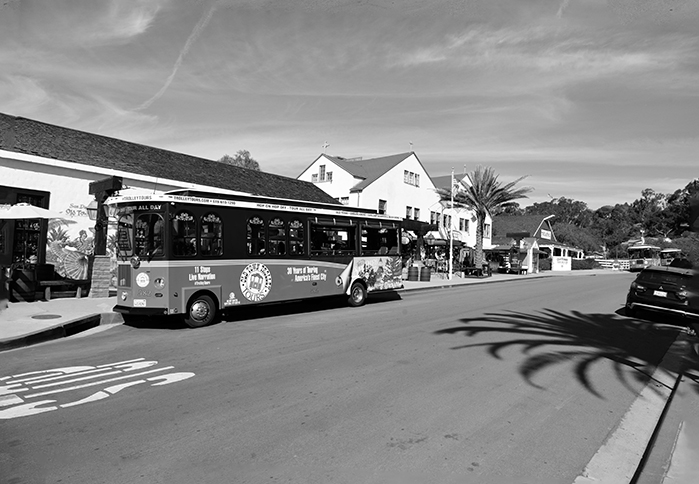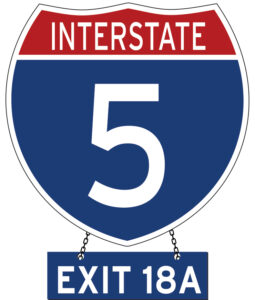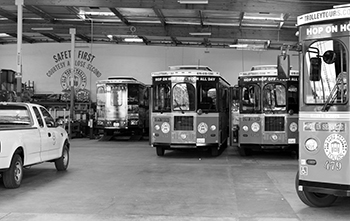
Chapter 29, Exit 18A (Pacific Highway): Old Town Trolley Tours
From Pacific Highway ramp, bear right onto Couts Street, turn right again on Kurtz Street, and right once more onto Bandini Street. The Old Town Trolley barn at 2115 Kurtz Street will be on your left.

 The “trolley barn” is where the vehicles owned by Old Town Trolley Tours of San Diego are kept overnight and maintained. It is also where the cast of the sightseeing company report to work before going off to their assignments in San Diego and Coronado. For those who want to take the tour, the easiest place to catch it is at the corner of Twiggs and San Diego Avenue alongside Old Town San Diego State Historic Park.
The “trolley barn” is where the vehicles owned by Old Town Trolley Tours of San Diego are kept overnight and maintained. It is also where the cast of the sightseeing company report to work before going off to their assignments in San Diego and Coronado. For those who want to take the tour, the easiest place to catch it is at the corner of Twiggs and San Diego Avenue alongside Old Town San Diego State Historic Park.
This chapter is a chance for me to step again from third-person history into first-person history because I was highly involved in the start-up in 1989 of Old Town Trolley Tours of San Diego. It came about because through The Harrison Enterprises, the public relations agency which I owned, I served as the executive director of the San Diego Cruise Industry Consortium. The consortium was created in 1983 under the aegis of Acting Mayor Bill Cleator to attract cruise ships to the Port of San Diego. Previously, I had served as communications director for Cleator during the period he served as a city councilman and acting mayor.

As part of the consortium’s successful effort to attract cruise ships to our port, I attended a conference sponsored by the Cruise Lines International Association (CLIA) in Miami, Florida. During one session at which presidents of various cruise lines spoke, I asked their opinion about the prospects for more cruise calls on the West Coast of the United States, specifically in San Diego. That question caught the attention of Chris Belland and Ed Swift, the Key West-based partners of Historic Tours of America. They approached me during a break in the proceedings and told me that they were interested in learning more about San Diego and whether it might be a good locale for sightseeing trolleys (they are buses configured to look like trolleys) such as the ones they operated in Key West, Florida. I accepted their invitation to accompany them to Key West to see their operation there and to talk more about San Diego.
After arriving in Key West, I rode on the narrated tour of the Old Town Trolley there, as well as on the fabled Conch Tour Train, and saw how these vehicles integrated into a single tour such well-known Key West destinations as the Southernmost Point of the continental United States, Ernest Hemingway’s favorite bar, the Little White House that Harry S Truman used for vacations, Mallory Square, and Key West’s Aquarium, the latter of which was staffed by personnel of Historic Tours of America. I told Chris and Ed that San Diego already had a small sightseeing trolley operation called the Molly Trolley which connected various San Diego venues but without a scripted narration such as was featured on the Old Town Trolley.
The two HTA principals asked if I would be willing to research some of the questions that would face them if they started up a sightseeing operation in San Diego. What kind of permits and licenses would be needed? What would be a good route for the trolley to take? What historical information, stories, and anecdotes could be incorporated into a script?
I went back to San Diego and researched the information and reported back to them. They asked me if I would serve as the start-up general manager of Old Town Trolley of San Diego, at least until another general manager could be found. With the responsibilities of my public relations agency, including the marketing efforts toward the cruise ship industry, I was not able to give full time to this endeavor. However, I was able to collaborate on the initial script, participate in the hiring of the first cast of drivers, ticket sellers, and mechanics and to get the operation up and running. For a while, Molly Trolley, with its five trolleys, tried to compete against Old Town Trolley, but because we had the benefit of a narration and the long experience of the owners in Key West, it wasn’t long before Tom Hamilton, owner of the Molly Trolley and a former member of the San Diego County Board of Supervisors, agreed to sell to us the five Molly Trolleys, bringing the Old Town Trolley fleet to 13. That enabled us to have trolleys pass each point on the 2-hour sightseeing tour every 20 minutes, and still have some trolleys left over for charter operations.
Our enthusiasm for San Diego history knew no bounds and so we dressed up our ticket sellers in costumes of such famous San Diego personages as explorer Juan Rodriguez Cabrillo, Father Junipero Serra, author and sailor Richard Henry Dana, Army scout Kit Carson, gunslinger and gambler Wyatt Earp, his wife Josephine Earp (née Sarah Marcus), Sea Captain Charles M. Scammon, Zookeeper Belle Benchley, and even Helen Hunt Jackson’s fictional character “Ramona.” When the trolley would stop at their ticket locations, a ticket seller would come aboard, introduce himself or herself by the character’s name, and recite some of “their” history. When not making these cameo appearances, the ticket sellers had two functions: first, of course, to sell tickets, and second, to entertain the crowd in case a trolley with no seating left passed them by.
Having “characters” was exciting but from a cost and efficiency standpoint, it proved too problematic and the program was dropped.
We wanted the narration of our trolley drivers to stay focused on the landmarks that they were driving by. Sometimes, however, the drivers would get so absorbed in the story that they were telling that they might go on past the relevant landmark and miss entirely the opportunity to talk about it. To help them stay on track, we had a “sound bite” program on a tape recording which the driver could stop or start by pressing a special button. Missing a stop would put the sound bites out of sequence, an embarrassing situation that the drivers all wished to avoid.
After I was replaced as a general manager, I stayed on with Historic Tours of America operation as a vice president of the parent company, while still serving as the principal of The Harrison Enterprises. While I was the vice president, we experimented with some new technology for testing the readiness of drivers to take the wheel. The drivers had been routinely subjected to random testing for alcohol or drugs to make certain that they never drove while impaired. The experiment was with a scored virtual driving system – reminiscent of the type found in entertainment arcades – that the drivers needed to pass before they would be sent out on the route. The experimental system was judged more expensive and no more effective than the conventional drug testing system and was dropped.
During my watch, a Catholic convent near the intersection of San Diego and Twiggs Avenue came up for sale, and Chris and Ed jumped at the chance to buy it because of its strategic location. In Key West, they gained considerable revenue from selling souvenirs at Mallory Square and wanted to do the same thing at Old Town San Diego State Historic Park. If they had opened a souvenir shop inside the park, it would have been subject to restrictions that the State of California’s Park and Recreation Department enforces on vendors to be historically accurate. However, the convent was a church-owned enclave at the lip of the park, and therefore was not subject to the same restrictions. The convent building was converted by Historic Tours of America into a market selling a wide variety of souvenir items, not only those relating to the 1820-1870 historic timeline.
There were some sensitive issues to be negotiated concerning the large statue of Jesus that had been on the property. During the Vietnam War, the statue had become a place for the reading of the names of local members of the Armed Forces who were killed in action. Eventually, plaques also had been placed at the foot of the statue. This unofficial configuration had the distinction of being the first Vietnam Memorial in the nation. Chris and Ed realized that the statue and the memorial plaques sometimes drew crowds that spilled over onto the sidewalk and the street where the trolleys operated – a safety hazard. I was tasked with finding a way to move both the statue of Jesus – a ticklish assignment for this Jew – as well as the plaques honoring our brave members of the Armed Forces.
In negotiations with local Vietnam veterans, we found a suitable place for the plaques in a grove at the side of the Veterans Memorial Museum in Balboa Park. Old Town Trolley paid for the relocation of the plaques, thereby helping to provide a much more appropriate venue for solemn observances. Old Town Trolley also paid to have the statue of Jesus gently uprooted and delivered to the Prince of Peace Abbey in Oceanside, where with outstretched arms, the statue found a natural home. All was well that ended well.
*
Next Sunday, July 24, 2022: Exit 18B (Washington Street): San Diego County Sheriff’s Museum
This story is copyrighted (c) 2022 by Donald H. Harrison, editor emeritus of San Diego Jewish World. It is an updated serialization of his book Schlepping and Schmoozing Along Interstate 5, Volume 1, available on Amazon. Harrison may be contacted via donald.harrison@sdjewishworld.com